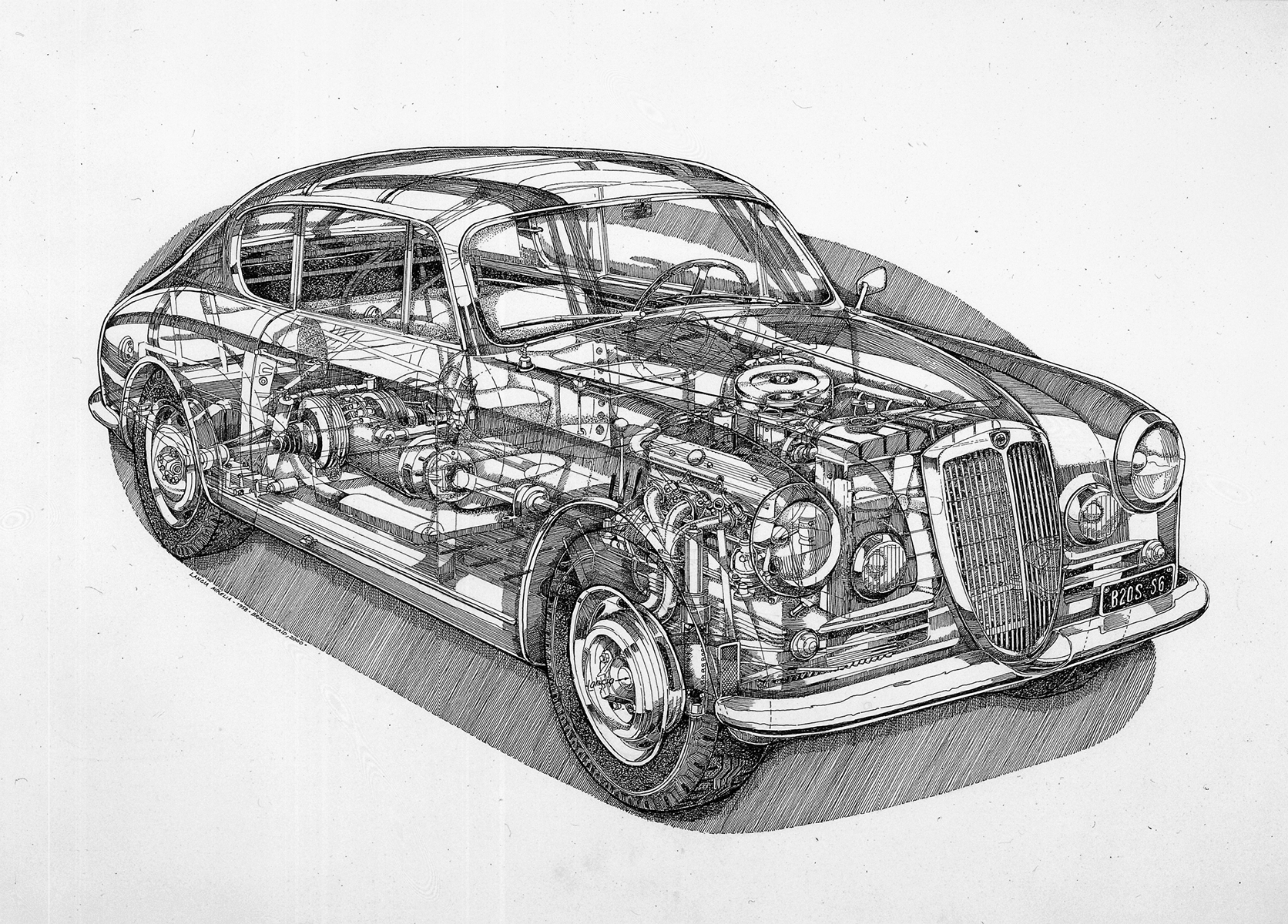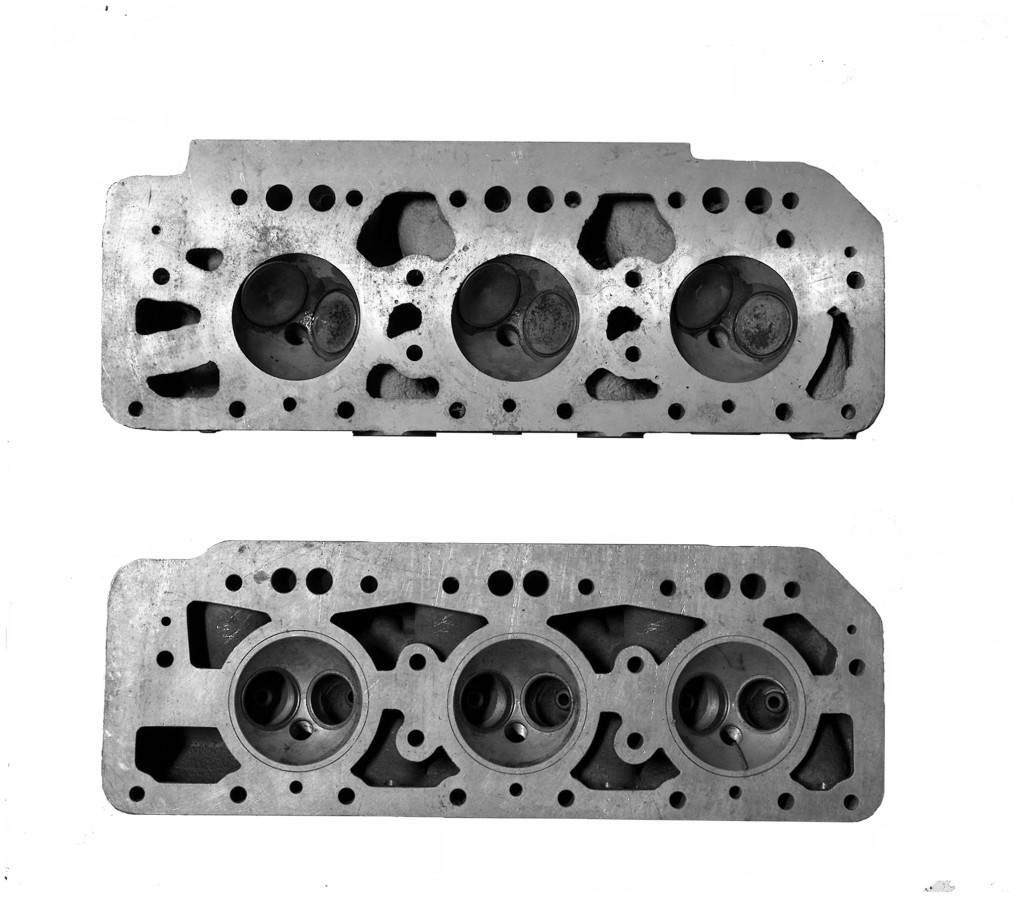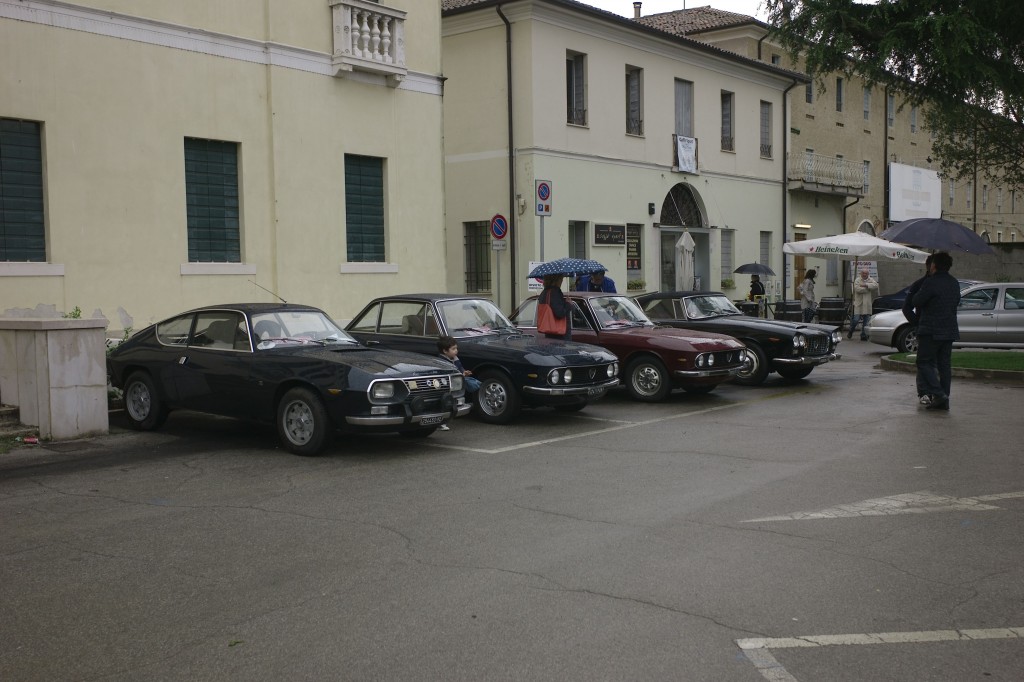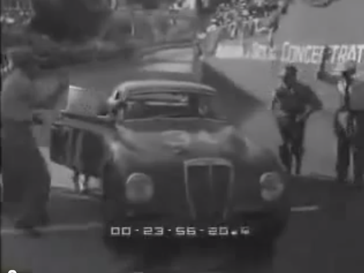Archive for the ‘Aurelia’ Category
Brian Kinkaid
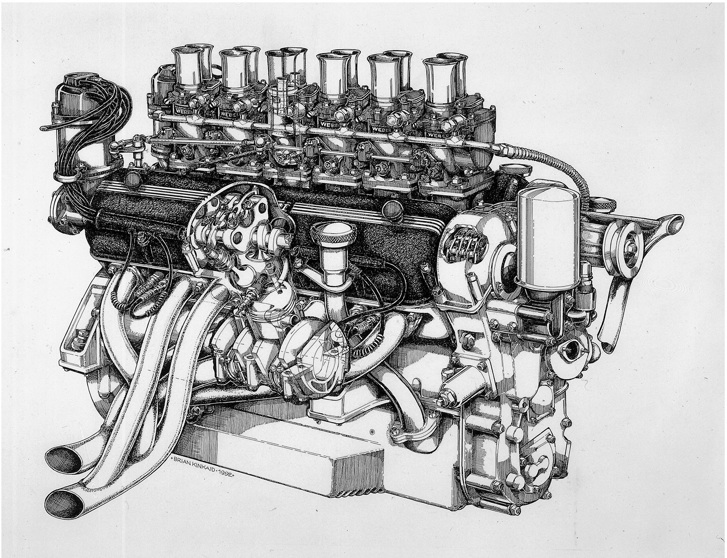
The older Lancia world in the US was a wonderful collection of talented and thoughtful people who appreciated design and well made things. Mike Miller was one such person in New York, Brian Kinkaid was another in Chicago.
I met Brian years ago in a communal car storage/workspace that exists in a low brick loft building in an industrial part of Chicago. Brian had been in charge of the graphic production for the Sears catalogs, but in the change to new technologies, had been let go. He had only a little money, a B20 and a very talented drawing hand. He did the Ferrari motor above, and then the B20 car below late in his life in 2000. Lovely work.
I’d go visit him on Saturday afternoons, where he’d be putzing with something (for years he was trying to restore an Invicta), and we’d share our affection for Aurelias with Italian opera in the background.
His 6th series car was a lovely example, lightly worn, all original. When he was thinking of selling it, sadly he preferred it go out of town than to one of several people here who would have loved it to stay. It went to good hands on the east coast.
Brian was known in Chicago for his skill, but never really was understood in the larger market. The drawing skill belies the complex character that was never far underneath, wondering about technology, art and beauty in a world that seemed to have moved on. Brian is no longer with us, but the drawings are – as are the memories of a glass of wine, a moment of reflection in the dusk of the afternoon.
More of his work can be seen at
form and practicality
two heads – B20 s.1 and s.4
Over the life of the Aurelia there were many changes to the car. In fact, from the s. 1 to s. 6 B20, it is hard to find components that were not changed, mostly small bits here and there as all the major parts were revised. Some of these changes were due to learning more about what was needed for a part to work. This can be seen in a comparison of the engine heads from a s.1 B20 from 1951 with a s.4 B20 of 1954/55.
The most striking difference is in the water passages – in the earlier head, they are precisely shaped, as drawn by an engineer, and carefully and formally arranged. Quite nicely so. A few years later, a different picture emerges – the passages in the s.4 head are located slightly differently, and shaped practically. Probably easier to cast, and likely more effective.
Its a small item, buried away inside the engine and no one will ever see it. But its one of the many changes that tell of the dialogue at that time between Lancia’s engineers and their production. Its a dialogue that goes on today, still. Form and practical – two ideas that need each other, as neither does well without the other.
Wheel Color?
So what color were those Lancia white wheels? In general, stock steel wheels from Lancia (Aprilia through Fulvia) were painted a Lancia creamy white, often called Avorio Antico. Finding that color in today’s paints can be difficult, although there is one English paint company that lists it on a website. People have tried to determine a modern equivalent to this color:
1. Jean Marie Levallois did some careful research on Aurelias and found some original white color (unfaded) behind some bits on his car before it was painted. He noted:
“On the back-side of the half-ring of horn control, there is an original avorio antico paint having resisted time (fading)… It matches Dupont de Nemours for fiat/lancia: code color 234, avorio antico, 1967 to 1975 (old colors were translated into new chemical formules), number 36194. You use it in one measure with two of pure white and you will have the right colour…with patina.”
2. I have used the color of Summer Beige, Nissan RF, 1994-2006, or Glasurit SM 003.50 to match Jean Marie’s white. I was quite happy with this color. For my B20, which is painted a light beige, I used this color in the central part of the wheel, and the outer rim was painted the color of the car. This “two tone” approach was used in period by Lancia, although perhaps not consistently.
3. Don Cross has noted that for Appias:
“The nearest match I have found to the cream colour is a Rover colour called Arum White and I have used this on my cars.”
4. Paolo (PG 1964 on line) notes that the correct color for Lancia wheels in the mid-1960‘s was Avorio Chantilly, which he noted as Lechler32/MaxMeyer12043,, with its color formula: 
5.Posted 10.2014 was this from Klaus Jeschke on VivaLancia.com. I don’t know him or how accurate this is, but he says the ICI Paint code for the wheels is:
buttermilk BS4800/10C31 ICI paint recipe: P425-900 356.0 gms, P420-904RT 372.4gm, P420-908RT 379.5gm, P420-905 408.8gm, P190-376 586.5 gm,Hellfenbein P4206Bp9
6. Recently (4.2016) from the Alfa Romeo BB, from Don000:” For those unable to access Lechler / Max Meyer color references, # 430B5 seems to be the best match in the Asko Sikkens book for the Lancia wheel color.”
New blog site and comments
Welcome to the new blog site. The site was moved because Apple stopped hosting, and the new blog software is more robust. Some of the older entries have been getting updated, so its worth checking your old favorites. Please update your links to the main LanciaInfo site as www.lanciainfo.com.
However, there is a big glitch: comments that were on the site (and valued) appear to have been lost. A lot of effort went into saving them – I thought they were archived so they could (at worst) be moved to the new site. However, I’ve learned that this was only a link to Apple’s site, which deleted them from the archive.
This is really unfortunate and I owe all of you who have made comments an apology. While I’m a big Apple fan, this is the second time that Apple relocated or adjusted their hosting and comments were lost both times. Really frustrating.
The site has been moved to a WordPress platform, and is no longer based on Apple software, but on “professional” blogging software. It is highly unlikely this will happen again. It does mean that files, photos, and large images can be posted more freely, so that is better.
But if you have the urge, please post comments and add your thoughts. Your feedback is really valued.
Aurelia brakes
Many a complaint has been heard about Aurelia brake judder. Various theories have been offered, but the most likely problem is an ill-fit between the shoe and the drum: if the drum and shoe are not cut to the same radius, differential wearing will occur, and may lead to judder.
Shown above is a Zanchi cutter, period type, cutting the shoes on Nigel Trow’s s. 3 B20. Here in the US, I’ve had good luck with Tony Nicosia, who does this for brake shoes and drums.
Aurelia conference in Italy
A conference on the Aurelia took place Saturday, May 12 at Volpago del Montello (north of Treviso), birthplace of Engineer Ugo Gobbato (General Manager of Alfa Romeo in the 40’s and the father of Eng. Pier Ugo).
Called “L’innovazione di Gianni Lancia: l’Aurelia”, it was put on by Parolin Marino, President Club, and organized by Getulio Ferri. The conference began with Marcello Minerbi and featured a DVD of Lancia made some years ago by Fiat, with interesting historical information and images. Also presenting was Giuseppe Marelli, a racer of the Aurelia years ago.
Outside the conference were found a number of Aurelias and other Lancias, lovely to see. There was a very nice Flaminia sedan and a number of Fulvia Zagatos.

at the conference: Manfredi Lancia (center) and his wife (left), organizer Getulio Ferri (right) and Luigi De Virgilio (kneeling).
After the conference, there was a glorious dinner, full of good company and even more food. The following day, a few of us went to visit a collection of Fulvia Zagatos, including one of the first four made, along with Gamma coupes, and a couple of Super Jollys. Unusual but nice to see all together.
For those who are interested, there is an Aurelia meeting in Valsesia (near Fobello) in September as well.
Targa Florio
From Giovanni De Virgilio comes a link to youtube video on the Targa Florio in the 1950s. While the quality is nothing wonderful, in the first three minutes you get to see the 1952 s.2 Corsas and the1953 D20 in motion, with a wee bit of sound. Special, tantalizing and leaves you wanting more. Imagine…. Bonetto winning by pushing across the finishing line.
Targa Florio in the ’50 – YouTube
The Third Driveshaft
It is well accepted that Aurelias came with two styles of driveshafts – the first type (s. 1-4) was a two piece shaft with rubber “spyders” and aluminum paddles. The second type (s. 5-6) was also a two piece shaft with hexagonal doughnuts and larger driveshaft tubes. It was used in the Flaminia also and is similar to that in later Alfa V6 cars and the Porsche 924-944. A more complete article has been posted at: driveshafts (1.12).
There was yet one other driveshaft, a third type, used in the Aurelia – the B12 had a totally different driveshaft, a one piece shaft running from the engine to the transaxle. It also had two centering rubber mounts instead of the more typical one used in the split shaft. Of course, not all B12s were like this – the earlier ones were different – as this was used on the later ones.
And to be complete, the early driveshafts with the rubber spyders varied also, as the first group (I think B20 s. 1-2) had paper thin bushings to center them in the shafts, and later ones had more solid bronze bushings about 2mm thick. Not interchangeable.
Do the words “constant development” apply here?
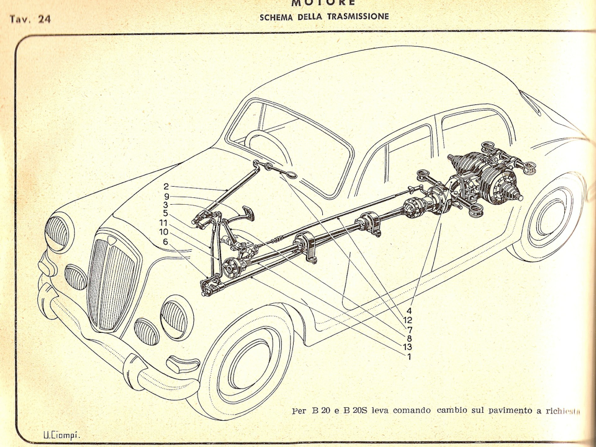
from the B12 parts book, showing the overall layout of the third type of driveshaft

from the B12 parts book
Bracco’s B20?
 Reportedly, it is Bracco’s Mille Miglia car, and has the serial number to match. If so, this is a most important car. Now in England, it is hoped that documentation of the details of this important and so far unrestored B20 will be made available.
Reportedly, it is Bracco’s Mille Miglia car, and has the serial number to match. If so, this is a most important car. Now in England, it is hoped that documentation of the details of this important and so far unrestored B20 will be made available.
Found in Missouri, then Texas, now in England, comes news of a most interesting B20. Reportedly stored away after the Carrera Panamerica of 1951, this s. 1 B20 was stored in a barn for many years. Recently uncovered, it features the following:
- series 1 B20 instruments, and misc. details.,
- early Nardi kit, including manifold and two carbs,
- small seats, early interior,
- a chopped roof and modified rear body


Fettling
It takes time to get it right. But when you do, it is very rewarding. Silk.
Remember the line:
“when she was good, she was very good, and when she was bad….”
The B20 is now out on the road from months of slumber. The gearbox was rebuilt by Buck Williams in Pittsburgh, son of Bob WIlliams (Aurelia restorer). Apart from nashing his teeth on Harleys, Buck also knows Aurelia gearboxes. Seems like there were a few old bearings, and some tolerances that weren’t as good as they could be. A bit more fine tuning, and its now as an Aurelia box should be – crisp, tight, and right on the mark.
The car has been out and about. After finding the right switch arrangement so the electric fuel pump actually supplies fuel to the carbs (in case of vapor lock), things are looking up. Retorquing the head from last year’s engine rebuild, tightening up the valves, and all is well. The new spin-on oil filter and bigger pump gives high pressure but the oil stays very clean. The 2 liter engine runs cool, never really over 165º, even in traffic. All in all, a really nice combination.
Went to a small auto lineup show (coffee gathering) in the northern suburbs on Sunday, where three (!) Lancias came together – a Fulvia Coupe of Sam Dannenberger, and Mark Schaeffer’s Integrale. All in the Chicago area, very nice cars. Hard to believe. Picture will be added.
The B20 is beginning to settle into a happy mode. Some clutch balancing eliminated driveline vibration – heck, at highway speeds you can’t even tell there’s a driveshaft. Cruises nicely at about 65, and then settles again very nicely at about 4300 rpm, around 80+. The engine just gets on its hind legs and starts to spin freely up high. It will be fun to share this with other Aurelia owners, and the differences between the 2 and 2.5 liter motors. Its pretty interesting that the performance from the 2 liter is so interesting with the stock cam. Says something about factory development.
The car and I are off to northern Michigan for a vacation. Will see how it goes.
